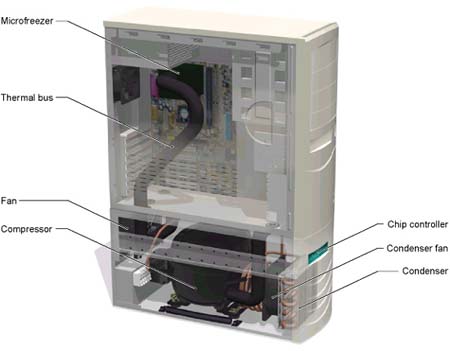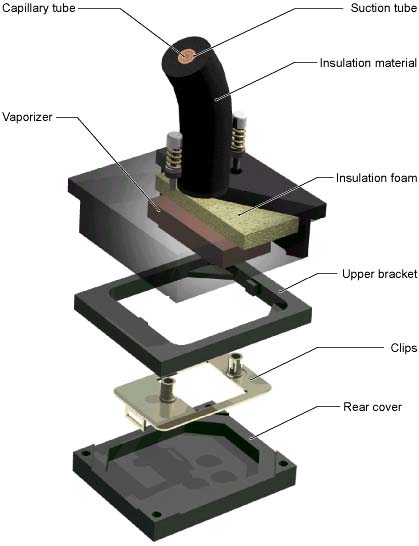Chip-Con Prometeia Cooling System
First of all it must be noted that Chip-con have taken utmost care to ensure that their Prometeia cooling system second to none. Chip-con have partnered up with a Danish manufacture called Elcold Denmark who are specialists in chest freezers and coolers since 1961. So you’re guaranteed to have a very reliable cooling system without doubt.
The case was sent to us by Chip-con over in Denmark and it was packed in quite a large box to ensure the safety of the unit during transit, and thankfully there was no damage to the unit at all. One thing you should be aware is that this unit weighs ton; well at least it seemed like that :). Actually the unit weighs around 27 -30kg I would imagine, so don’t plan on moving it around too much.
Looking at the Prometeia cooling system you can’t help but realize what a simple yet innovative design it really is. One of the main contrasting differences between the Prometeia cooling system and the Vapochil system is that in the latter, the cooling mechanism is located at the top of the casing whereas Prometeia have intelligently placed it right at the bottom. Therefore any leakage (If by some chance) or condensation that might occur during operation of the case will not affect the PC system at all. On the Vapochill system condensation will occour due to the fact that vapour diffusion penetrates the insulation sponges, unless the system is so heavily loaded that it never gets below the dew point, in which case your CPU isn’t very cold at all. On the Prometeia Condensation cannot take place inside the processor as it is hermetically sealed off.

The main components that make up the Prometeia cooling system can be clearly identified separately. The top consists of a pretty basic Enlight EN-7328 Midi tower metal casing which has been slightly modified to accommodate the Microfreezer and the cooling unit. The Midi ATX case consists of four 5 ¼” drive bays and three 3 ½” drive bays, allowing decent amount of expansion. The casing alone is considerably heavy since it’s metal, nevertheless opting for an aluminum case would be totally impractical.
The total unit is around 6cm taller than our Lian-Li PC75 casing, which makes the Prometeia system look quite a monstrosity. Some of you might be tempted to add a modified window kit to show off the internal workings of the Prometeia system. Personally I would love to do something of this sort and maybe add a blue neon light into the setup as well. This would certainly make the system one of the coolest looking and coolest performing setups that one could ever buy. Maybe we’ll actually carry out this mod at a later time for your viewing pleasure.
Chip-con states that you could also add your own case if you deem it’s nicer than the Enlight case. You’ll need to make sure that the new case has similar dimensions as the cooling unit and you’ll also need to cut a whole big enough for the thermal bus to pass through. The existing casing is attached to the cooling unit by a few bolts, so it’s merely a matter of removing them and placing the new case.
Components of the Cooling unit
The cooling unit which lies below the case is comprised of the following components.
- Compressor
- Condenser
- Digital Chip Controller
- Microfreezer
- One 120mm rear exhaust fan
- One Condenser fan
- Thermal bus to carry the coolant to the Microfreezer

As you can see, the big black container in the center of the cooling unit is the compressor. Right in front are the compressor coils. The setup in the cooling unit looks pretty simple and basic, however there’s much more going on behind the eye which is technically very advanced. The compressor is driven directly from the Mains supply (115/230V) and consumes around 130W. Depending on the workload of the processor this might vary. So this avoids the requirement for a high performance PSU as some of you might have thought. For the PC components it’s recommended to have at least a 300W PSU for better overclocking results and stability. Chip-con sells two high performance PSU if you wish to go for; they carry a 433W Enermax unit and a 500W Leadman PSU.

The Microfreezer is where you attach the CPU. Once again this is another very complex design, which has been perfected by Chip-con. The Microfreezer has a built in heating element, which makes sure no condensation will form on the outside surface. During operation you’ll notice that the top of the MicroFreezer is quite hot, but that’s perfectly normal and you shouldn’t be concerned.